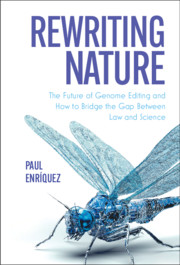Book contents
- Rewriting Nature
- Rewriting Nature
- Copyright page
- Dedication
- Summary of Contents
- Contents
- Figures
- Foreword
- Acknowledgments
- Table of Cases
- Abbreviations
- 1 A Momentous Time for Humankind
- 2 How an Idea Became a Reality
- 3 What Is Genome Editing?
- 4 Molecular Paraphernalia
- 5 What Can Genome Editing Be Used for?
- 6 Redesigning Food
- 7 Regulating Bioengineered Food
- 8 Redesigning Humanity
- 9 DNA and the Administrative State
- 10 Constitutional Predicaments
- 11 Science, Law, and Policy
- 12 Epilogue
- Index
10 - Constitutional Predicaments
Published online by Cambridge University Press: 11 June 2021
- Rewriting Nature
- Rewriting Nature
- Copyright page
- Dedication
- Summary of Contents
- Contents
- Figures
- Foreword
- Acknowledgments
- Table of Cases
- Abbreviations
- 1 A Momentous Time for Humankind
- 2 How an Idea Became a Reality
- 3 What Is Genome Editing?
- 4 Molecular Paraphernalia
- 5 What Can Genome Editing Be Used for?
- 6 Redesigning Food
- 7 Regulating Bioengineered Food
- 8 Redesigning Humanity
- 9 DNA and the Administrative State
- 10 Constitutional Predicaments
- 11 Science, Law, and Policy
- 12 Epilogue
- Index
Summary
The constitutional structure that supports our democratic system recognizes certain fundamental rights involving human liberties. These rights are considered so important that any governmental action impinging on them warrants examination under strict scrutiny, a legal standard that imposes a high bar for the government. Under strict scrutiny, the government must articulate a compelling purpose for enforcing a law encroaching fundamental rights and prove there are no less restrictive means to accomplish the law’’s purpose. Some fundamental rights, such as the freedom of speech and the right to vote, are enumerated in the Constitution. Others, including the rights to procreate, marry, exercise parental autonomy, make medical-care decisions, and others, are unenumerated yet also recognized as fundamental under the Constitution. But where do these rights come from? What, if anything, do they have in common with genome-editing technologies? This chapter examines novel issues related to genome editing and constitutional law. It surveys modern-day due process and equal protection jurisprudence to evaluate whether existing precedents define a cognizable fundamental right to select uses of germline genome editing. The chapter further illustrates the dangers of ignoring or misinterpreting science in constitutional law and analyzes the involuntary sterilization of “mentally defective”individuals legalized under Buck v. Bell.
Keywords
- Type
- Chapter
- Information
- Rewriting NatureThe Future of Genome Editing and How to Bridge the Gap Between Law and Science, pp. 330 - 359Publisher: Cambridge University PressPrint publication year: 2021

